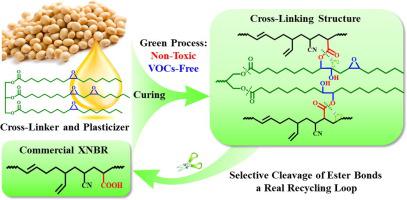Science Bulletin ( IF 18.9 ) Pub Date : 2020-03-10 , DOI: 10.1016/j.scib.2020.03.008 Ganggang Zhang , Haoran Feng , Kuan Liang , Zhao Wang , Xiaolin Li , Xinxin Zhou , Baochun Guo , Liqun Zhang

|
Currently adopted cross-linking methods in rubber industry are suffering from variable persistent issues, including the utilization of toxic curing packages, release of volatile organic compounds (VOCs) and difficulties in the recycling of end-of-life materials. It is of great importance to explore a green cross-linking strategy in the area. Herein, we report a new “green” strategy based on hydrolyzable ester cross-links for cross-linking diene-typed elastomers. As a proof of concept, a commercial carboxylated nitrile rubber (XNBR) is efficiently cross-linked by a bio-based agent, epoxidized soybean oil (ESO), without any toxic additives. ESO exhibits an excellent plasticization effect and excellent scorch safety for XNBR. The cross-linking density and mechanical properties of the ESO-cured XNBR can be manipulated in a wide range by changing simply varying the content of ESO. In addition, zinc oxide (ZnO) performs as a catalyst to accelerate the epoxide opening reaction and improve the cross-linking efficiency, serving as reinforcement points to enhance the overall mechanical properties of the ESO-cured XNBR. Furthermore, the end-of-life elastomer materials demonstrate a closed-loop recovery by selectively cleaving the ester bonds, resulting in very high recovery of the mechanical performance of the recycled composites. This strategy provides an unprecedented green avenue to cross-link diene elastomers and a cost-effective approach to further recycle the obtained cross-linked elastomers at high efficiency.
中文翻译:

面向绿色工艺的弹性体的下一代交联结构设计和真正的循环利用
橡胶工业中目前采用的交联方法面临各种持久性问题,包括使用有毒硫化包,释放挥发性有机化合物(VOC)和回收报废材料方面的困难。探索该地区的绿色交联策略非常重要。在此,我们报告了一种基于可水解酯交联的新“绿色”策略,用于交联二烯型弹性体。作为概念证明,商用羧化丁腈橡胶(XNBR)可通过生物基试剂环氧化大豆油(ESO)有效交联,而无需使用任何有毒添加剂。ESO对XNBR表现出优异的增塑效果和优异的防焦烧安全性。只需改变ESO的含量即可改变ESO固化XNBR的交联密度和机械性能。此外,氧化锌(ZnO)用作催化剂以加速环氧化物的开放反应并提高交联效率,并作为增强ESO固化XNBR整体机械性能的增强点。此外,寿命终止的弹性体材料通过选择性地裂解酯键而表现出闭环恢复,从而导致回收的复合材料的机械性能得到非常高的恢复。该策略为交联二烯弹性体提供了前所未有的绿色途径,并提供了一种经济高效的方法来进一步高效回收所获得的交联弹性体。氧化锌(ZnO)用作催化剂以加速环氧化物的开放反应并提高交联效率,并充当增强ESO固化XNBR整体机械性能的增强点。此外,寿命终止的弹性体材料通过选择性地裂解酯键而表现出闭环恢复,从而导致回收的复合材料的机械性能得到非常高的恢复。该策略为交联二烯弹性体提供了前所未有的绿色途径,并提供了一种经济高效的方法来进一步高效回收所获得的交联弹性体。氧化锌(ZnO)用作催化剂以加速环氧化物的开放反应并提高交联效率,并充当增强ESO固化XNBR整体机械性能的增强点。此外,寿命终止的弹性体材料通过选择性地裂解酯键而表现出闭环恢复,从而导致回收的复合材料的机械性能得到非常高的恢复。该策略为交联二烯弹性体提供了前所未有的绿色途径,并提供了一种经济高效的方法来进一步高效回收所获得的交联弹性体。寿命终止的弹性体材料通过选择性裂解酯键而表现出闭环恢复,从而使回收的复合材料的机械性能得到非常高的恢复。该策略为交联二烯弹性体提供了前所未有的绿色途径,并提供了一种经济高效的方法来进一步高效回收所获得的交联弹性体。寿命终止的弹性体材料通过选择性裂解酯键而表现出闭环恢复,从而使回收的复合材料的机械性能得到非常高的恢复。该策略为交联二烯弹性体提供了前所未有的绿色途径,并提供了一种经济高效的方法来进一步高效回收所获得的交联弹性体。


























 京公网安备 11010802027423号
京公网安备 11010802027423号